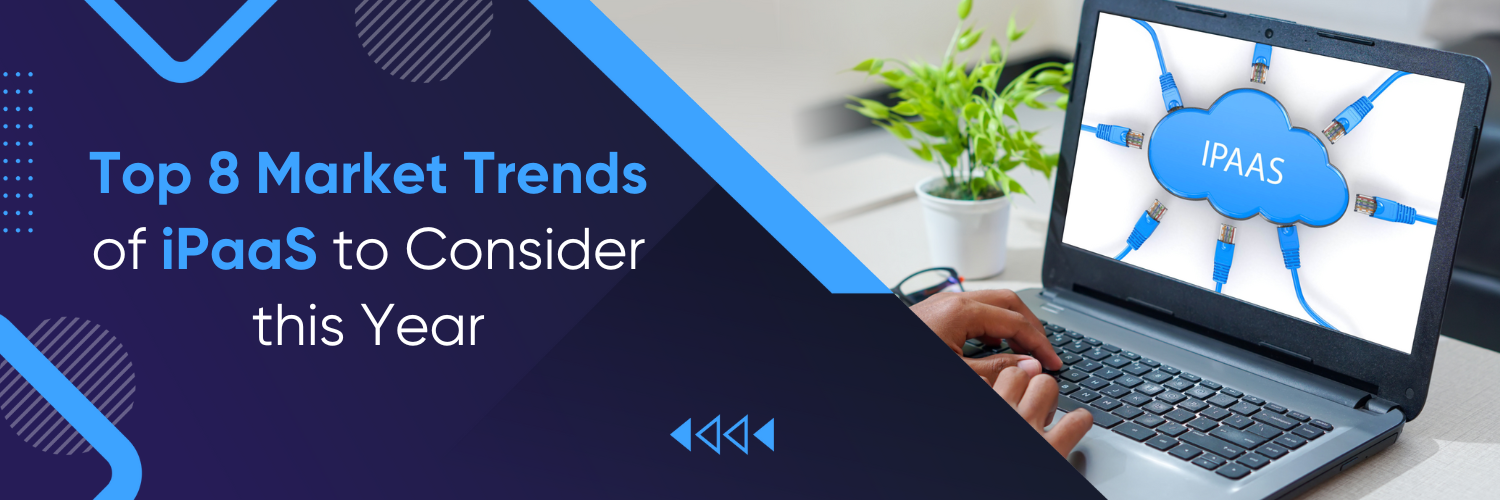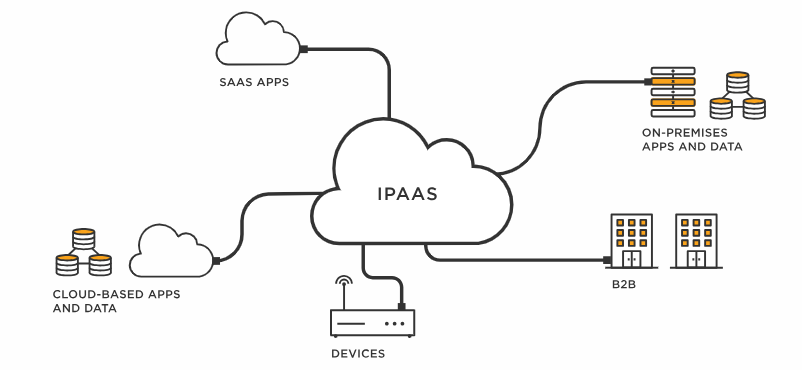iPaaS Market Trends
Businesses nowadays opt for seamless integration of applications, systems, and data has become imperative for organizations seeking to stay competitive.
Integration Platform as a Service (iPaaS) has emerged as a powerful solution to address the complexities of integration in a cloud-based environment. iPaaS offers businesses the ability to connect disparate systems, streamline workflows, and harness the power of data-driven insights.
As we embark on a new year, organizations need to stay updated with the latest market trends in iPaaS to make informed decisions and drive digital transformation initiatives. In this blog, we will explore the top eight market trends of iPaaS that businesses should consider to leverage the full potential of this integration solution.
Trend 1 – Increased Adoption of iPaaS Solutions
One of the prominent market trends of iPaaS is the significant increase in its adoption by businesses of all sizes. Organizations are recognizing the value of iPaaS in simplifying complex integration processes and achieving a unified view of their data. By leveraging iPaaS solutions, businesses can eliminate manual coding and reduce the time and resources required for integration projects.
The adoption of iPaaS brings several benefits to organizations. Firstly, it enables faster time-to-market for new initiatives, allowing businesses to quickly respond to changing market demands. Additionally, iPaaS facilitates seamless integration with both on-premises and cloud-based applications, enabling a hybrid IT environment that combines the best of both worlds. This flexibility empowers organizations to leverage existing systems while taking advantage of the scalability and agility offered by the cloud.
Statistics and market data further support the increasing adoption of iPaaS solutions. According to a recent industry report, the iPaaS market is expected to experience a compound annual growth rate (CAGR) of XX% over the next five years. This growth can be attributed to the rising demand for efficient data integration and the need for businesses to establish interconnected ecosystems.
Benefits:
- One of the prominent benefits of increased iPaaS adoption is the simplification of complex integration processes. Organizations can eliminate manual coding and reduce the time and resources required for integration projects.
- iPaaS enables faster time-to-market for new initiatives, allowing businesses to quickly respond to changing market demands.
- iPaaS facilitates seamless integration with both on-premises and cloud-based applications, enabling a hybrid IT environment that combines the best of both worlds.
- Statistics and market data support the benefits of iPaaS adoption, showcasing its potential for streamlining operations and establishing interconnected ecosystems.
Trend 2 – Expansion of Cloud-Based iPaaS Offerings
Another significant trend in the iPaaS landscape is the expansion of cloud-based iPaaS offerings. Traditionally, iPaaS solutions were primarily deployed on-premises, requiring organizations to invest in infrastructure and maintenance. However, with the emergence and maturation of cloud computing technologies, iPaaS has shifted towards cloud-based deployment models.
Cloud-based iPaaS platforms offer several advantages over their on-premises counterparts. Firstly, they eliminate the need for organizations to invest in hardware and infrastructure, reducing upfront costs and enabling scalability. Organizations can leverage the elasticity of the cloud to scale their integration capabilities as needed, accommodating changing business requirements.
Several major cloud-based iPaaS providers have emerged in the market, each offering a unique set of features and capabilities. For example, Provider X offers a comprehensive iPaaS solution with pre-built connectors and robust data transformation capabilities. Provider Y focuses on real-time event-driven integrations, allowing organizations to react quickly to data changes and triggers. The expanding range of cloud-based iPaaS providers enables organizations to choose the platform that aligns best with their specific integration needs.
Benefits:
- Cloud-based iPaaS platforms eliminate the need for organizations to invest in hardware and infrastructure, reducing upfront costs and enabling scalability.
- The elasticity of the cloud allows organizations to scale their integration capabilities as needed, accommodating changing business requirements.
- Major cloud-based iPaaS providers offer unique features and capabilities, providing organizations with a range of options to choose from based on their specific integration needs.
Trend 3 – Focus on Data Integration and Management
Efficient data integration and management have become critical components of iPaaS solutions. As organizations accumulate vast amounts of data from various sources, it becomes imperative to ensure seamless data flow and maintain data quality throughout the integration process.
To address this trend, iPaaS providers are leveraging emerging techniques and technologies for data integration. For instance, they are incorporating Extract, Transform, Load (ETL) and Extract, Load, Transform (ELT) processes to efficiently extract data from source systems, transform it to the desired format, and load it into target systems. Additionally, providers are adopting data virtualization techniques to provide a unified view of data, regardless of its physical location or format.
Benefits:
- Efficient data integration and management provided by iPaaS ensure seamless data flow and maintain data quality throughout the integration process.
- iPaaS providers incorporate techniques such as ETL and ELT processes to efficiently extract, transform, and load data into target systems.
- Data virtualization techniques are used to provide a unified view of data, regardless of its physical location or format.
Trend 4 – Integration with Artificial Intelligence and Machine Learning
The integration of Artificial Intelligence (AI) and Machine Learning (ML) capabilities into iPaaS platforms is gaining momentum. AI-powered iPaaS solutions enable intelligent data mapping, automated workflows, and predictive analytics, unlocking valuable insights from integrated data. For example, AI algorithms can analyze patterns in customer behavior and suggest personalized offers or automate decision-making processes. However, implementing AI and ML in iPaaS comes with challenges, such as data quality, model training, and ethical considerations, which organizations need to address to reap the full benefits.
Benefits:
- AI-powered iPaaS solutions enable intelligent data mapping, automated workflows, and predictive analytics, unlocking valuable insights from integrated data.
- AI algorithms can analyze patterns in customer behavior and suggest personalized offers or automate decision-making processes.
- Organizations can benefit from AI and ML capabilities in iPaaS, but challenges such as data quality and model training need to be addressed.
Trend 5 – Hybrid iPaaS Solutions for On-Premises and Cloud Integration
As organizations increasingly adopt a hybrid IT infrastructure, the demand for hybrid iPaaS solutions is rising. Hybrid iPaaS enables seamless integration between on-premises systems and cloud-based applications, allowing businesses to leverage their existing investments while embracing the advantages of the cloud. However, deploying hybrid iPaaS comes with challenges such as maintaining data consistency, ensuring security across hybrid environments, and selecting the right integration patterns. Best practices include thorough planning, implementing data synchronization mechanisms, and leveraging hybrid integration platforms.
Benefits:
- Hybrid iPaaS enables seamless integration between on-premises systems and cloud-based applications, allowing businesses to leverage existing investments while embracing the advantages of the cloud.
- Hybrid iPaaS solutions maintain data consistency, ensure security across hybrid environments, and provide flexibility in selecting integration patterns.
Trend 6 – Focus on Low-Code/No-Code Development in iPaaS
Low-code and no-code development approaches are gaining popularity in the iPaaS space, empowering citizen developers to create integrations and workflows with minimal coding knowledge. Low-code iPaaS platforms offer visual interfaces, drag-and-drop functionality, and pre-built connectors, enabling rapid development and deployment of integrations. This trend reduces the reliance on specialized IT resources, accelerates time-to-value, and empowers business users to build their own integrations. Successful low-code/no-code iPaaS implementations have been observed in industries like e-commerce, marketing automation, and HR management.
Benefits:
- Low-code/no-code iPaaS platforms offer visual interfaces, drag-and-drop functionality, and pre-built connectors, enabling rapid development and deployment of integrations.
- This trend reduces the reliance on specialized IT resources, accelerates time-to-value, and empowers business users to build their own integrations.
- Successful low-code/no-code iPaaS implementations have been observed in industries like e-commerce, marketing automation, and HR management.
Trend 7 – Enhanced Security and Data Privacy Features
With the increasing amount of data being exchanged and integrated via iPaaS, ensuring security and data privacy has become a critical concern. iPaaS providers are continuously enhancing their platforms with robust security features, including encryption, access controls, and threat detection mechanisms. Compliance standards such as GDPR (General Data Protection Regulation) and HIPAA (Health Insurance Portability and Accountability Act) play a vital role in shaping iPaaS security practices. Organizations must carefully evaluate the security features offered by iPaaS providers and ensure alignment with their regulatory requirements.
Benefits:
- iPaaS providers enhance their platforms with robust security features such as encryption, access controls, and threat detection mechanisms.
- Compliance with standards like GDPR and HIPAA ensures data privacy and protection.
- Organizations can evaluate the security features offered by iPaaS providers and ensure alignment with regulatory requirements.
Trend 8 – Integration of IoT and iPaaS
The convergence of IoT and iPaaS brings numerous opportunities for organizations to leverage the vast amount of data generated by IoT devices. iPaaS enables seamless integration of IoT devices, sensors, and data streams with other enterprise systems and applications. By integrating IoT with iPaaS, organizations can achieve real-time monitoring, predictive maintenance, and actionable insights. Examples of IoT-enabled iPaaS solutions can be found in industries such as manufacturing, logistics, and smart cities, where IoT devices are used for asset tracking, supply chain optimization, and environmental monitoring.
Benefits:
- Integration of IoT devices, sensors, and data streams with iPaaS enables real-time monitoring, predictive maintenance, and actionable insights.
- Organizations can leverage IoT-enabled iPaaS solutions in industries such as manufacturing, logistics, and smart cities for asset tracking, supply chain optimization, and environmental monitoring.
Conclusion
In conclusion, understanding and considering the top market trends in iPaaS is crucial for businesses looking to harness the power of integration and data-driven decision-making. The increased adoption of iPaaS, expansion of cloud-based offerings, focus on data integration and management, integration with AI and ML, hybrid deployment options, low-code/no-code development, enhanced security features, and IoT integration are all shaping the iPaaS landscape.
In the ever-evolving landscape of iPaaS, staying ahead of market trends is vital to securing a competitive edge. Ubique Digital Solutions stands at the forefront of this revolution, harnessing the power of these top market trends to propel businesses forward. As you navigate the intricate world of iPaaS this year, consider partnering with the experts. Boosting your business success isn’t just about following trends—it’s about leading with them. Take the next step in your digital transformation journey. Reach out to Ubique Digital Solutions today and forge a partnership that guarantees success.
FAQs
Q: How can iPaaS benefit my business?
iPaaS benefits businesses by streamlining operations, improving efficiency, enabling faster time-to-market, and facilitating data-driven insights. It offers centralized integration capabilities, eliminates manual processes, enhances collaboration, and enables seamless data flow across systems.
Q: Which industries are adopting iPaaS at a rapid pace?
Various industries are rapidly adopting iPaaS, including retail, healthcare, finance, manufacturing, and e-commerce. These sectors require efficient integration of customer data, backend systems, supply chains, and third-party applications to drive business growth and improve customer experiences.
Q: Are there any notable challenges in implementing iPaaS solutions?
Implementing iPaaS solutions may present challenges such as data quality and cleansing, compatibility with legacy systems, ensuring data security and compliance, and addressing potential integration complexities. However, these challenges can be mitigated with careful planning, selecting the right iPaaS platform, and partnering with experienced integration experts.






















